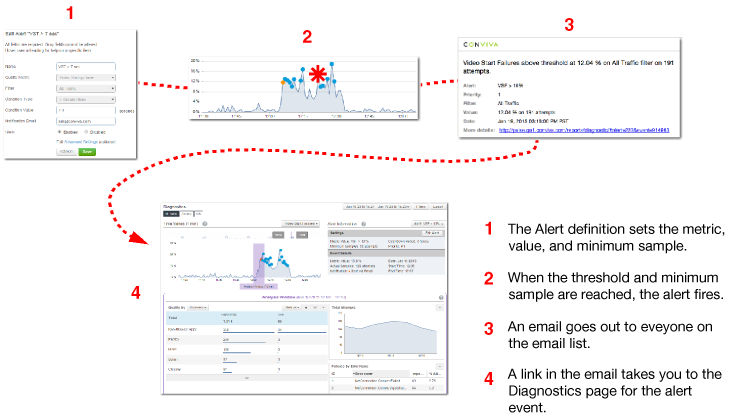Ad alerts are an important part of the Conviva Ads solution. You define the tripwires that send alerts to an email or phone to inform key stakeholders and enable corrective actions. Across your ad delivery chain, you can use Ads alerts to monitor the metrics that measure ad delivery, experience, and performance .
Note: Conviva generates alerts based on real-time data to minimize reporting latency, while Conviva renders data in Ads to ensure data is processed with a high level of confidence. As a result, there may be a delay of up to 5-10 minutes between when an alert is generated and when the related data is rendered for analysis.
How Ad Alerts Work
The Conviva ad alerts feature lets you automate the process of monitoring key ad quality and performance metrics, and emailing team members when ad alert conditions occur. You might watch for increases in Ad Start Failures (ASF) or Exits Before Ad Start (EBAS), both of which indicate viewers are not seeing the intended ads. Or, you can notify your Ad Ops team when spikes in Ad Play Failures (APF) indicate a sudden increase in ad delivery or network issues.
Ad alerts actually consist of several moving parts.

First, there’s the ad alert definition that tells the system what data set (filter) and metric to monitor as well as the conditions (threshold and sample size) that trigger an alert. The definition also includes a cool down period (how long to wait between consecutive emails for an ad alert), a priority, and a list of people to email when the ad alert is triggered. You can create as many ad alerts as you need.
Once the condition for the ad alert is met, the system fires off an email to your recipients to let them know that a significant event has occurred. An event is an instance where the conditions of the ad alert are met. There can be many events associated with an ad alert, each of which provides diagnostic information that can help you troubleshoot your ad delivery and performance.
A link in the ad alert email takes recipients to the corresponding Ad Diagnostics page, where they can see the data that triggered the ad alert. These ad diagnostic snapshots are retained for 30 days.
For more information about creating and managing alerts, see Ads Alerts Dashboard and Ad Diagnostics.